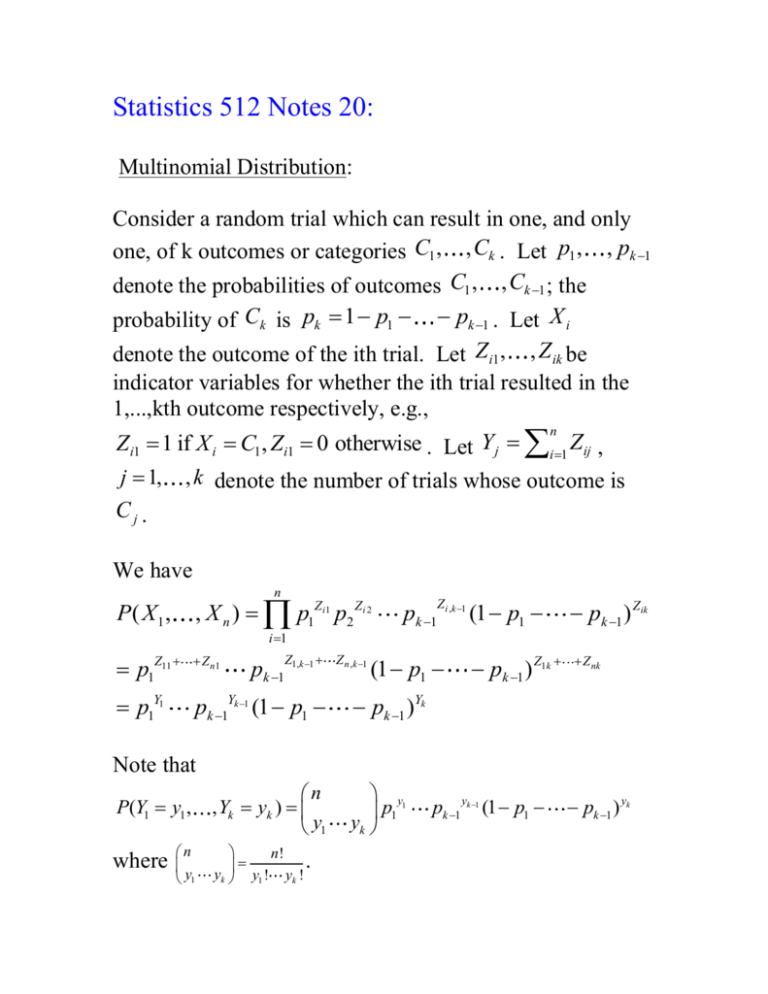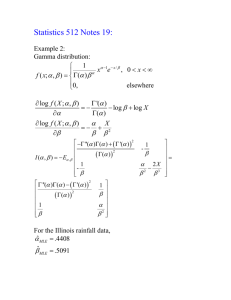Statistics 512 Notes 20: - Wharton Statistics Department
advertisement

Statistics 512 Notes 20: Multinomial Distribution: Consider a random trial which can result in one, and only one, of k outcomes or categories C1 , , Ck . Let p1 , , pk 1 denote the probabilities of outcomes C1 , , Ck 1 ; the probability of Ck is pk 1 p1 pk 1 . Let X i denote the outcome of the ith trial. Let Zi1 , , Zik be indicator variables for whether the ith trial resulted in the 1,...,kth outcome respectively, e.g., n Zi1 1 if X i C1 , Zi1 0 otherwise . Let Yj i 1 Zij , j 1, Cj . , k denote the number of trials whose outcome is We have n , X n ) p1Zi1 p2 Zi 2 P( X 1 , i 1 Z1,k 1 Z n ,k 1 p1Z11 Z n1 p1Y1 pk 1Yk 1 (1 p1 pk 1 pk 1 Zi ,k 1 (1 p1 (1 p1 pk 1 ) Z1k pk 1 ) Zik Z nk pk 1 )Yk Note that P(Y1 y1 , where n y1 n , Yk yk ) y1 n! . yk y1 ! yk ! y1 p yk 1 pk 1 yk 1 (1 p1 pk 1 ) yk The likelihood is l ( p1 , pk 1 ) Y1 log p1 Yk 1 log pk 1 (n Y1 Yk 1 ) log(1 p1 pk 1 ) The partial derivatives are: Y n Y1 Yk 1 l 1 p1 p1 1 p1 pk 1 ,..., Y n Y1 Yk 1 l k 1 pk 1 pk 1 1 p1 pk 1 Yj It is easily seen that pˆ j , MLE n satisfies these equations. See (6.4.19) and (6.4.20) in book for information matrix. Goodness of fit tests for multinomial experiments: For a multinomial experiment, we often want to consider a model with fewer parameters than p1 , , pk 1 , e.g., p1 f1 (1 , , q ), , pk 1 f k 1 (1 , , q ) (*) where q k 1 and ( , , ) To test if the model is appropriate, we can do a “goodness of fit” test which tests H 0 : p1 f1 (1 , , q ), , pk 1 f k 1 (1 , , q ) for some (1 , , q ) vs. H a : H 0 is not true for any (1 , , q ) 1 q We can do this test using a likelihood ratio test where the number of extra parameters in the full parameter space is D (k 1) q 2 so that 2 log (( k 1) q) under H 0 . Example 2: Linkage in genetics Corn can be starchy (S) or sugary (s) and can have a green base leaf (G) or a white base leaf (g). The traits starchy and green base leaf are dominant traits. Suppose the alleles for these two factors occur on separate chromosomes and are hence independent. Then each parent with alleles SsGg produces with equal likelihood gametes of the form (S,G), (S,g), (s,G) and (s,g). If two such hybrid parents are crossed, the phenotypes of the offspring will occur in the proportions suggested by the able below. That is, the probability of an offspring of type (S,G) is 9/16; type (SG) is 3/16; type (S,g) 3/16; type (s,g) 1/16. Alleles of first parent Alleles SG Sg of SG (S,G) (S,G) second Sg (S,G) (S,g) parent sG (S,G) (S,G) Sg (S,G) (S,g) sG (S,G) (S,G) (s,G) (s,G) sg (S,G) (s,G) (s,G) (s,g) The table below shows the results of a set of 3839 SsGg x SsGg crossings (Carver, 1927, Genetics, “A Genetic Study of Certain Chlorophyll Deficiencies in Maize.”) Phenotype Starchy green Starchy white Sugary green Sugary white Number in sample 1997 906 904 32 Does the genetic model with 9:3:3:1 ratios fit the data? Let X i denote the phenotype of the ith crossing. Model: X 1 , , X n are iid multinomial. P( X i SG ) pSG , P( X i Sg ) pSg , P( X i sG ) psG , P( X i sg ) psg H 0 : pSG 9 /16, pSg 3/16, psG 3/16, psg 1/16 H1 : At least one of pSG 9 /16, pSg 3/16, psG 3/16, psg 1/16 is not correct. Likelihood ratio test: max L( ) (9 /16)1997 (3 /16)906 (3 /16)904 (1/16)32 max L( ) (1997 / 3839)1997 (906 / 3839)906 (904 / 3839)904 (32 / 3839)32 9 /16 3 /16 906 log 1997 / 3839 906 / 3839 3/16 1/16 904log 32 log ) 387.51 904/3839 3839 2 log 2*(1997 log Under H 0 : pSG 9 /16, pSg 3 /16, psG 3 /16, psg 1/16 , 2 log ~ 2 (3) [there are three extra free parameters in H1 ]. 2 Reject H 0 if 2 log .05 (3) 7.81 . Thus we reject H 0 : pSG 9 /16, pSg 3 /16, psG 3 /16, psg 1/16 . Model for linkage: 1 1 1 1 pSG (2 ), pSg (1 ), psG (1 ), psg 4 4 4 4 Y Y Y 1 2 3 1 1 1 1 L( ) (2 ) (1 ) (1 ) 4 4 4 4 n Y1 Y2 Y3 Maximum likelihood estimate of for corn data = 0.0357, see handout. Test 1 1 1 1 (2 ), pSg (1 ), psG (1 ), psg vs. 4 4 4 4 H1 : pSG , pSg , psG , psg do not satisfy H 0 : pSG 1 1 1 1 (2 ), pSg (1 ), psG (1 ), psg 4 4 4 4 for any ,0 1 pSG max L( ) (.25*(2 .0357))1997 (.25*(1 .0357))906 (.25*(1 .0357))904 (.25*.0357)32 max L( ) (1997 / 3839)1997 (906 / 3839)906 (904 / 3839) 904 (32 / 3839)32 2 log 2.02 2 Under H 0 , 2 log ~ (2) [there are two extra free parameters in H1 ]. 2 2 log .05 (2) 5.99 Linkage model is not rejected. Sufficiency Let X 1 , , X n denote the a random sample of size n from a distribution that has pdf or pmf f ( x; ) . The concept of sufficiency arises as an attempt to answer the following question: Is there a statistic, a function Y u ( X1 , , X n ) which contains all the information in the sample about . If so, a reduction of the original data to this statistic without loss of information is possible. For example, consider a sequence of independent Bernoulli trials with unknown probability of success . We may have the intuitive feeling that the total number of successes contains all the information about that there is in the sample, that the order in which the successes occurred, for example, does not give any additional information. The following definition formalizes this idea: Definition: Let X 1 , , X n denote the a random sample of size n from a distribution that has pdf or pmf f ( x; ) , . A statistic Y u ( X1 , , X n ) is said to be sufficient for if the conditional distribution of X 1 , , X n given Y y does not depend on for any value of y . Example 1: Let X 1 , , X n be a sequence of independent Bernoulli random variables with P( X i 1) . We will verify that Y i 1 X i is sufficient for . Consider P ( X1 x1 , , X n xn | Y y) n For y i 1 xi , the conditional probability is 0 and does not depend on . n For y i 1 xi , n P ( X 1 x1 , , X n xn | Y y ) P ( X 1 x1 , , X n xn , Y y ) P (Y y ) y (1 )n y 1 n y n n y (1 ) y y The conditional distribution thus does not involve at all and thus Y i 1 X i is sufficient for . n Example 2: Let X 1 , , X n be iid Uniform( 0, ). Consider the statistic Y max1i n X i . We have shown before (see Notes 1) that ny n 1 0 y fY ( y ) n 0 elsewhere For Y , we have P ( X 1 x1 , , X n xn | Y y ) P ( X 1 x1 , , X n xn | Y y ) P (Y y ) 1 I n Y 1 n 1 n 1 ny n IY ny which does not depend on . For Y , P ( X1 x1 , , X n xn | Y y) 0 . Thus, the conditional distribution does not depend on and Y max1i n X i is a sufficient statistic Factorization Theorem: Let X 1 , , X n denote the a random sample of size n from a distribution that has pdf or pmf f ( x; ) , . A statistic Y u ( X1 , , X n ) is sufficient for if and only if we can find two nonnegative functions, k1 and k2 such that f ( x1; ) f ( xn ; ) k1[u( x1 , , xn ); ]k2[( x1 , , xn )] where k2 [( x1 , , xn )] does not depend upon .











